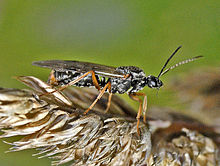| Formica rufa species group | |
|---|---|

| |
| Formica rufa worker | |

| |
| Formica rufa group winged male | |
| Scientific classification | |
| Kingdom: | |
| Phylum: | |
| Class: | |
| Order: | |
| Family: | |
| Subfamily: | |
| Genus: | |
| Species group: | F. rufa species group
|
The Formica rufa group is a subgeneric group within the genus Formica, first proposed by William Morton Wheeler. This group contains the mound-building species of Formica commonly termed "wood ants" or "thatch-mound ants", which build prominent nests consisting of a mound of grass, litter, or conifer needles.[1] The species Formica rufa or the red wood ant is the type species of this subgroup.

This particular group can inhabit open deciduous woodlands, dense pine forests, and even moorland. Workers vary in size, the largest reaching about 10 millimetres (0.39 in) long. They can produce formic acid in their abdomens and eject it 12 centimetres (4.7 in) in the air when threatened.[2] The only function of males is to mate in flight with queens.[2] Species previously attributed to the Microgyna group were transferred to the F. rufa group by the Wheelers in 1986.[citation needed]
- ^ Gösswald, Karl (1989). Die Waldameise 1. Wiesbaden: Wiesbaden : Aula-Verlag. ISBN 3-89104-475-5.
- ^ a b Dr Timothy Batchelor Msu.edu - Southern red wood ant Formica rufa